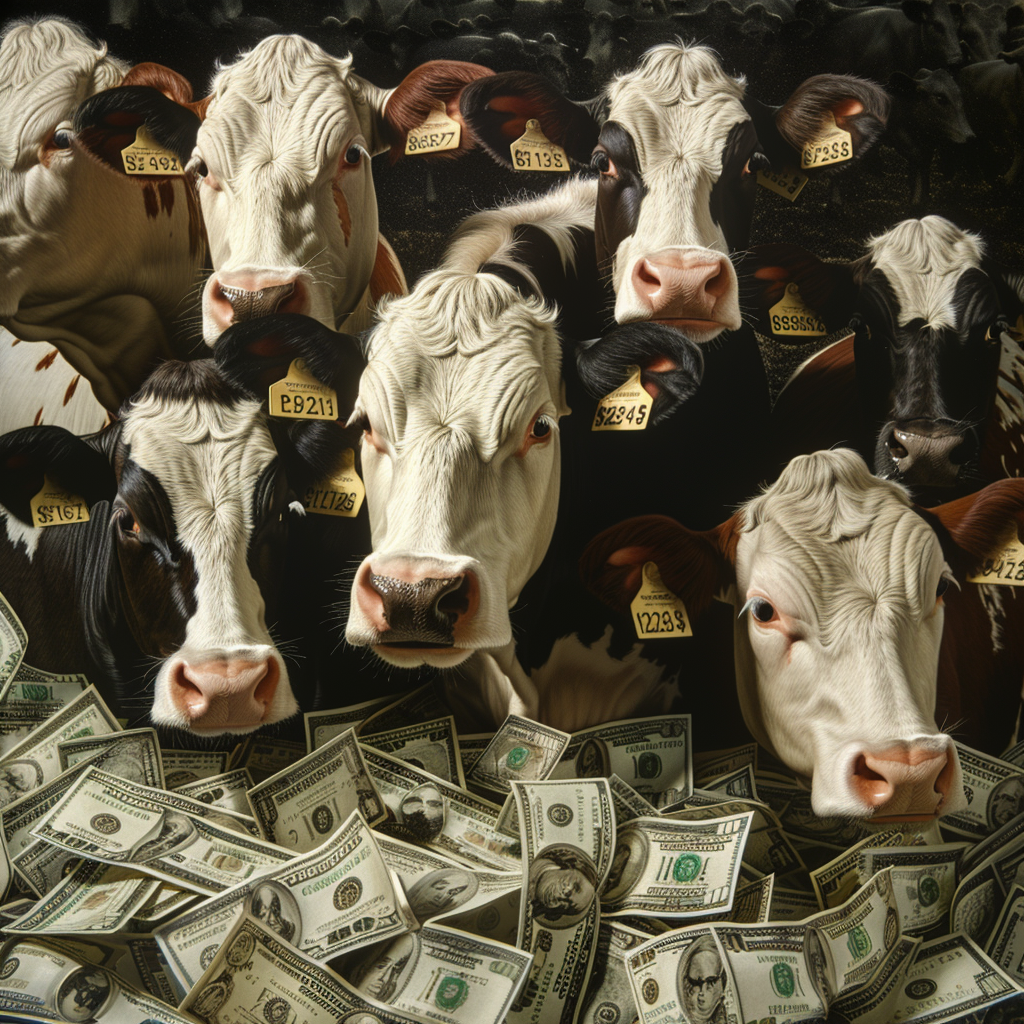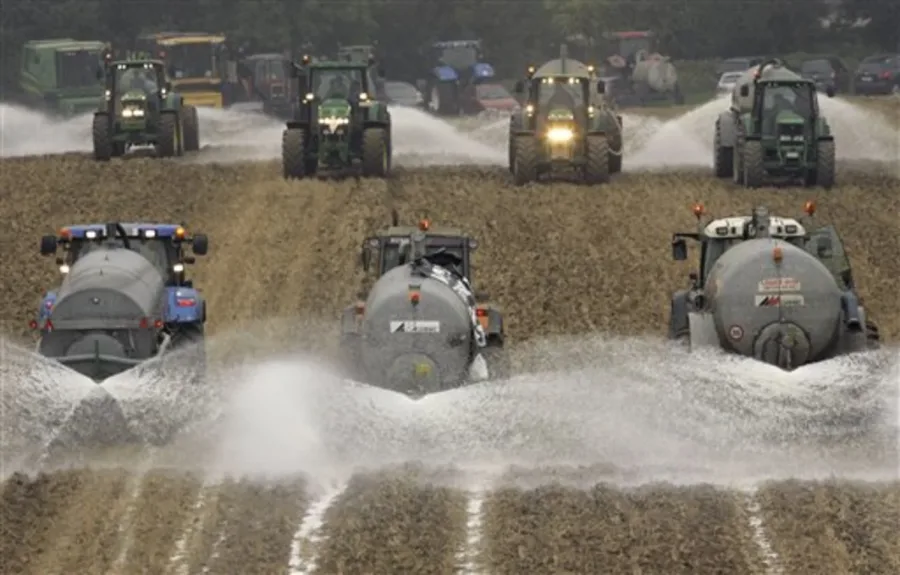Think record-low farm bankruptcies mean smooth sailing? Think again. Rising costs and falling prices could spell trouble for dairy farmers.
Summary: Are we seeing a beacon of hope for struggling dairy farmers or just a temporary respite? Farm bankruptcies hit a record low in 2023, but economic challenges persist. Despite fewer Chapter 12 filings, rising production costs, falling commodity prices, and an outdated farm bill cast long shadows over American agriculture. With net farm income projected to drop nearly 40% from 2022 levels and farm numbers dropping by over 140,000 between the 2017 and 2022 Census, this reduction in bankruptcies, spurred by record-high commodity prices and revenues in 2022, might be just a blip in a larger trend of financial hardship.
- Farm bankruptcies reached a record low in 2023.
- Despite fewer Chapter 12 filings, economic challenges remain significant.
- Rising production costs and falling commodity prices are major concerns for farmers.
- The outdated 2018 farm bill contributes to financial instability in agriculture.
- Net farm income is projected to drop nearly 40% from 2022 levels.
- The total number of farms declined by over 140,000 between the 2017 and 2022 Census.
- The decrease in bankruptcies may be temporary, driven by record-high prices in 2022 rather than long-term financial health.

Consider celebrating record-low agricultural bankruptcies while preparing for a financial storm. That sounds paradoxical. Despite a record low in Chapter 12 bankruptcy filings, the future of many dairy producers is far from assured. Although commodity prices rose in 2022, net farm income predictions 2024 remain gloomy. Rising production costs, obsolete safety nets, and rising debt loads jeopardize the sustainability of American agriculture. How prepared are you for the following challenges? “The government safety net that normally supports farmers when markets hit bottom is currently undermined by inflation and an outdated 2018 farm bill.” Stay with me as we review the figures, regional details, and state data to determine what’s happening. Let’s discuss what this all implies for your farm’s future.
A Record Low in Farm Bankruptcies: Cause for Celebration or Caution?
| Year | Number of Bankruptcies | Percentage Change |
|---|---|---|
| 2019 | 599 | N/A |
| 2020 | 438 | -26.9% |
| 2021 | 276 | -37.0% |
| 2022 | 169 | -38.8% |
| 2023 | 139 | -17.8% |
The present condition of agricultural bankruptcy provides varied perspectives. In 2023, Chapter 12 bankruptcy filings reached a new low since the provision’s permanent inception in 2005. According to the United States Courts, 139 agricultural bankruptcies were filed, down 18% from the previous year and continuing a four-year downward trend that began in 2019, when there were 599 filings.
The decrease in bankruptcy cases is a testament to the historical success of Chapter 12. This success is not just a result of the record-high commodity prices and increased net farm revenues in 2022 but also the understanding of its historical background. Chapter 12, implemented in 1986 as a temporary solution, has allowed family farmers to continue operating while making appropriate debt repayments. Its success led to its permanent status in 2005, expediting the bankruptcy procedure for farmers and addressing the enormous debts often associated with agricultural companies.
The decrease in Chapter 12 filings may indicate an improvement in the farm’s financial health. While it only partially accounts for the multiple underlying issues, it does offer a glimmer of hope. Rising production costs, volatile commodity prices, and limited access to financing all pose considerable hazards to farm profitability. However, as we look to the future, the durability of this lower trend in bankruptcy is uncertain. The present low results are positive, but they must be seen in the context of overall farm financial health. It entails keeping track of growing expenses and market uncertainties that might reverse this trend. With the right strategies and support, there is potential for improvement in the future.
If You Think the Drop in Farm Bankruptcies Means Everything’s Rosy in Agriculture, Think Again!
| Economic Indicator | 2022 | 2023 | 2024 (Forecast) |
|---|---|---|---|
| Net Farm Income | $185.5 billion | $155 billion | $112 billion |
| Grain Prices (Corn per bushel) | $4.80 | $4.40 | $4.30 |
| Production Expenses Increase | 10% | 12% | 15% |
| Farm Debt at Commercial Banks | $709 billion | $744 billion | N/A |
| Farm Loan Delinquency Rate | 1.5% | 1.3% | 1.7% (est.) |
Assuming the decline in farm bankruptcies implies everything is well in agriculture, you should look at the overall financial picture. Farmers face a storm of decreased net farm income, falling commodity prices, and rising production expenses. Net farm income is predicted to fall by about 40% from its peak in 2022, from $185.5 billion to $155 billion in 2023. This is not a tiny decrease; it is expected to be the most substantial nominal loss for U.S. farmers on record and the third greatest when adjusted for inflation. Meanwhile, commodity prices are declining. Corn prices, for example, were initially forecast at $4.40 a bushel in February but were lowered to $4.30 in July. Prices for soybeans and wheat fell by 10 cents and 30 cents per bushel, respectively. Cotton prices dropped 12 cents per pound in only one month.
While revenues are down, costs are rising. Production costs have increased to record levels four years in a row, with a $17 billion increase expected in 2023 alone. The Perdue University-CME Group Ag Economy Barometer shows that farmers have consistently expressed concern about high input prices such as fertilizers and feeds. The debt position isn’t pretty much the same. U.S. agricultural debt increased to over $744 billion in 2023, up from $709 billion in 2022. This debt has grown more costly due to 11 interest rate rises by the Federal Reserve between March 2022 and January 2024, contributing to a 43% increase in aggregate U.S. agricultural interest payments in a single year.
The cumulative consequences of these financial constraints imply that many farmers are caught between a rock and a hard place, operating at high expenses. This ‘rock and a hard place’ is a metaphor for the difficult choices farmers are forced to make, such as whether to continue operating at high expenses or close down their farms due to decreasing income.
The Picture Isn’t the Same Across the Country: A Look at Regional Farm Bankruptcy Patterns
| Region | 2022 Bankruptcies | 2023 Bankruptcies | % Change |
|---|---|---|---|
| Northwest | 15 | 11 | -27% |
| Mid-Atlantic | 10 | 7 | -30% |
| Midwest | 50 | 42 | -16% |
| Southeast | 45 | 40 | -11% |
| Southwest | 11 | 14 | +27% |
| West | 11 | 11 | 0% |
| Other | 12 | 4 | -67% |
The image does need to be more consistent throughout the nation. Different areas exhibit different trends in agricultural bankruptcy cases. For example, Southwest had an increase in bankruptcies, with 14 filings in 2023 compared to 11 in 2022. Why? Extreme droughts in the area substantially influenced crops and market stability.
Meanwhile, the Northwest, Mid-Atlantic, Midwest, and Southeast filings decreased by double digits. The Midwest had the most filings (42), followed by the Southeast with 40. The drop might be attributable to improved weather conditions and more stable commodity pricing in these locations.
On a state level, Texas had the most significant rise in bankruptcies, with eight more instances than the previous year for a total of 10. Texas is a vast agricultural state, so even little interruptions like regional droughts or market instability may have a significant effect. Meanwhile, some states, notably New York, experienced fewer bankruptcy filings. In 2023, New York reported seven fewer occurrences than in 2022. This drop might be attributed to various causes, including successful state-level assistance programs and good economic circumstances.
Fourteen states boosted filings, with some barely significantly. For example, Missouri increased from one to six instances, whereas North Carolina increased from four to six. The Northeast and West areas had no substantial changes, suggesting a stable but fragile balance in their agricultural economies. Local economic circumstances are critical; areas with poor weather are inherently more vulnerable to financial stress, while locations with excellent weather and economic support experience fewer bankruptcies.
The 2018 Farm Bill: An Outdated Safety Net in a Time of Crisis
Farmers are banking on the 2018 farm bill, crafted and enacted during steady pricing, to help weather the present market turmoil. That farm law was implemented during six years of market instability, a worldwide pandemic, and unprecedented price inflation, which many of the farm bill’s initiatives could not sufficiently address. The 2018 agricultural bill, which is still in effect in 2024 after a 12-month extension, is based on obsolete reference prices that reduce the safety net to the financial floor and provide very little protection from bankruptcy. When output is reduced to the point that farm incomes decrease, the USDA, via the Agriculture Risk Coverage (ARC) or Price Loss Coverage (PLC) programs, makes payments to covered commodities based on historical yield levels and reference prices — the lowest market prices – on a farm’s base acreage. However, base acreage – the crop-specific acres on which a farm is eligible for farm bill programs – registered following the 2018 farm bill is 21 million acres less than the actual area planted in program crops. This disparity reduces the efficacy of ARC’s risk management advantages. The reference prices that trigger PLC payments are based on a price escalation that has not kept pace with inflation or input price hikes. Farms continue to suffer decreased revenue due to falling commodity prices, which are causing farm losses; nevertheless, for many farmers with no protection from obsolete farm bill provisions, we may face a near future of more agricultural financial difficulty.
Lessons From Past Crises: How History Informs Today’s Farm Financial Struggles
To grasp the issues that American farmers face now, it is necessary to review the history of agricultural financial crises in the United States. Farmers have been in difficult financial situations before.
In the 1980s, the United States faced a terrible agrarian crisis. High debt levels, declining crop prices, and increasing interest rates triggered a significant wave of farm foreclosures. Sounds familiar? By 1985, more than 200 farms were sold weekly. Her impact on rural America was substantial, leading to bankruptcies, consolidations, and a fall in family farms.
Looking at today’s agricultural financial challenges, it is evident that, although the terrain may alter, the cyclical character of these crises persists. Farmers face high input costs, price fluctuations, and changing global markets. The lessons of history tell us that, although encountering hardship is nothing new, perseverance and adaptability are still critical to surviving the storm.
Looking Ahead to 2024 and Beyond The Stark Reality Facing American Farmers
Looking forward to 2024 and beyond, many farmers face increased challenges. As financial constraints escalate, agricultural bankruptcies are expected to increase. The expected decline in net farm revenue and continued high production costs spell problems for farmers already operating on tight margins. According to the USDA, agricultural revenue in 2024 is predicted to fall by $43 billion from 2023. Furthermore, the cost of agricultural inputs continues to rise, increasing the financial burden on farming operations.
The present agricultural safety net, as expressed in the 2018 farm bill, demonstrates its age and limitations. Initially designed for a reasonably stable economic environment, it lacks support for today’s turbulent markets and high input prices. Consequently, farmers’ customary buffers are no longer adequate, exposing them to financial downturns. What we sorely need is policy intervention. An updated agricultural policy that reflects today’s economic reality may be helpful. This involves addressing inflation-adjusted reference pricing and increasing risk management advantages.
Without significant reforms, farmers’ financial prospects remain grim. The prospect of further bankruptcies remains substantial, and many farmers may face difficult choices concerning the future of their enterprises. Only then can we expect to alleviate financial challenges in the agriculture industry.
Ever Wonder What Steps Farmers Can Take to Safeguard Themselves Against Financial Pitfalls?
Have they ever wondered what actions farmers might take to protect themselves from financial pitfalls? There is more to the plan than meets the eye. Diversification, alternate income sources, and adopting new technology are all possible lifelines. Growing various crops allows farmers to mitigate the risk associated with market volatility and climatic effects particular to a crop. For example, if one crop fails or prices fall, others may still flourish, giving a critical financial buffer. Furthermore, diverse farms make better use of land and resources.
Another critical step is to look at other money sources. Have you considered agritourism or direct-to-consumer sales? These channels are becoming more popular, allowing farmers to engage directly with customers and generate additional cash. Farm tours, U-pick operations, and selling products at farmers’ markets or via subscription boxes may all make a significant impact.
Furthermore, using new technology may increase productivity and profitability. Precision agriculture, for example, enables farmers to utilize data analytics to manage crops better, reduce waste, and increase yields. Internet of Things (IoT) devices can monitor soil moisture levels, and drones can scan fields for insect concerns, allowing for early treatments. Understanding how to manage debt, make strategic investments, and negotiate agricultural finance institutions may help farmers make more educated choices. Have any of these techniques given you an idea for your farm?
The Bottom Line
While the recent decrease in Chapter 12 agricultural bankruptcies is encouraging, it merely touches the surface of farmers’ significant financial concerns. The data demonstrates both temporary alleviation and underlying difficulties, ranging from growing production costs and falling commodity prices to the burden of out-of-date agricultural safety measures. Fewer bankruptcies may only sometimes imply overall financial stability. As we look forward to 2024 and beyond, we must ask ourselves: How can farmers deal with these issues without significant changes and improved support systems?














